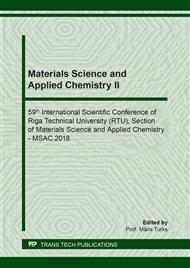[1]
Waste Management Association of Latvia Recycling of biodegradable organic waste using composting technologies, Latvia, 2007,28-29.
Google Scholar
[2]
Z. Lou, L. Wanga, Y. Zhao, Consuming un-captured methane from landfill using aged refuse bio-cover, Bioresource Technology. 102 (2011) 2328-2332.
DOI: 10.1016/j.biortech.2010.10.086
Google Scholar
[3]
D. Ying, C. Chuanyua, H. Bin, X. Yueenc, Z. Xuejuan, C. Yingxu, W. Weixiang, Characterization and control of odorous gases at a landfill site: A case study in Hangzhou, China, Waste Management. 32 (2012) 317-326.
DOI: 10.1016/j.wasman.2011.07.016
Google Scholar
[4]
A.S. Ball, E. Shahsavari, A. Aburto-Medina, K.K. Kadali, A.A.J. Shaiban, R.J. Stewart, Biostabilization of municipal solid waste fractions from an advanced waste treatment plant, Journal of King Saud University – Science. 29 (2017) 145-150.
DOI: 10.1016/j.jksus.2016.10.005
Google Scholar
[5]
EPA (1997). Landfill operational practices. Ardcavan, Wexford, Ireland.
Google Scholar
[6]
ASTM D6523-00 Standard Guide for Evaluation and Selection of Alternative Daily Covers (ADCs) for Sanitary Landfills. ASTM International (2005).
DOI: 10.1520/d6523-00r05
Google Scholar
[7]
O. Medne, R. Serzane, L. Berzina-Cimdina, The composition of alternative daily cover materials with a perspective of uUse of Latvian local resources, Material Science and Applied Chemistry. 32: (2015) 45-48.
DOI: 10.1515/msac-2015-0008
Google Scholar
[8]
M.D.S. Hossain, M.A. Haque, The effects of daily cover soils on the shear strength of municipal solid waste in bioreactor landfill, Waste Management. 29 (2009) 1568-1576.
DOI: 10.1016/j.wasman.2008.12.017
Google Scholar
[9]
P.J. Solan, V.A. Dodd, T.P. Curran, Evaluation of the odour reduction potential of alternative cover materials at a commercial landfill, Bioresource Technology. 101 (2010) 1115-1119.
DOI: 10.1016/j.biortech.2009.09.030
Google Scholar
[10]
J. He, F. Li, Y. Li, X. Cui, Modified sewage sludge as temporary landfill cover material, Water Science and Engineering. 8 (3) (2015) 257-262.
DOI: 10.1016/j.wse.2015.03.003
Google Scholar
[11]
Information on http://odourcontrol.co.nz/alternative-daily-cover.
Google Scholar
[12]
Information on http://www.lscenv.com/landfill-cover-systems-pg.html.
Google Scholar
[13]
Information on http://www.profileevs.com.
Google Scholar
[14]
Information on http://www.emeraldseedandsupply.com/hydroseeding/mulch_wastecover.html.
Google Scholar
[15]
Information on https://nepis.epa.gov.
Google Scholar
[16]
T.J. Nachtman, J.H. Hull, Self-foaming sprayable composition, U.S. Patent 5, 849, 364, (1998).
Google Scholar
[17]
T.J. Nachtman, J. Hull, P. O'Shea, Sprayable composition, U.S. Patent 5, 516, 830, (1996).
Google Scholar
[18]
R. Svinka, E. Petersone, A. Cimmers, V. Svinka, Sorption process in the illite type Latvian clays and thermal binding of heavy metal ions, Materials of Intern. Conf., Lithuania. Technology of Silicate,, Kaunas. (1998), 13-16.
Google Scholar
[19]
X. Qiang, L. Hai-Jun, L. Zhen-Ze, L.L. State, Cracking, water permeability and deformation of compacted clay liners improved by straw fiber, Engineering Geology. 178 (2014) 82-90.
DOI: 10.1016/j.enggeo.2014.05.013
Google Scholar
[20]
J. Prabakar, R. S. Sridhar, Effect of random inclusion of sisal fiber on strength behaviour of soil, Construction and Building Materials. 16 (2002) 123-131.
DOI: 10.1016/s0950-0618(02)00008-9
Google Scholar
[21]
M.A. Budihardjoa , A. Chegenizadehb, H. Nikraz, Application of wood to sand-slag and its effect on soil strength, Procedia Engineering. 102 (2015) 640-646.
DOI: 10.1016/j.proeng.2015.01.155
Google Scholar
[22]
G. Sakale, M. Knite, V. Teteris, Polyisoprene-nanostructured carbon composite (PNCC) organic solvent vapour sensitivity and repeatability, Sensors and Actuators A: Physical. 171(1) (2011) 19-25.
DOI: 10.1016/j.sna.2011.02.013
Google Scholar
[23]
G. Sakale, D. Jakovlevs, I. Aulika, M. Knite, Effect of nanotube aspect ratio on chemical vapour sensing properties of polymer/MWCNT composites, Journal of Nano Research. 21 (2013) 117-123.
DOI: 10.4028/www.scientific.net/jnanor.21.117
Google Scholar


